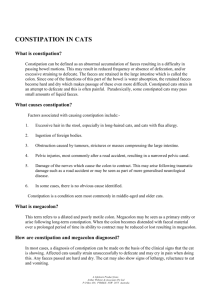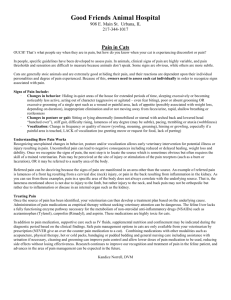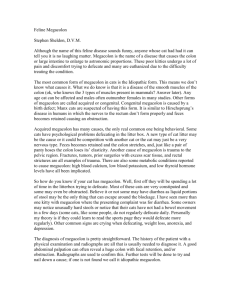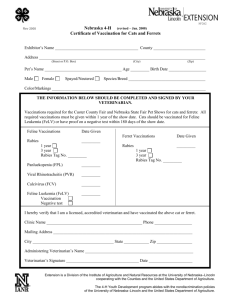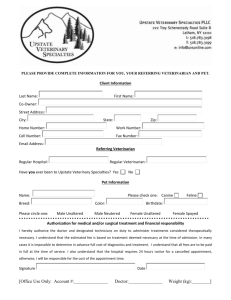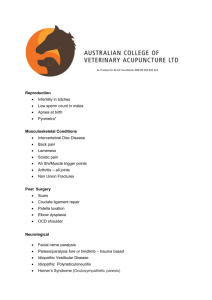FELINE IDIOPATHIC MEGACOLON - Derrimut Road Veterinary Centre
advertisement
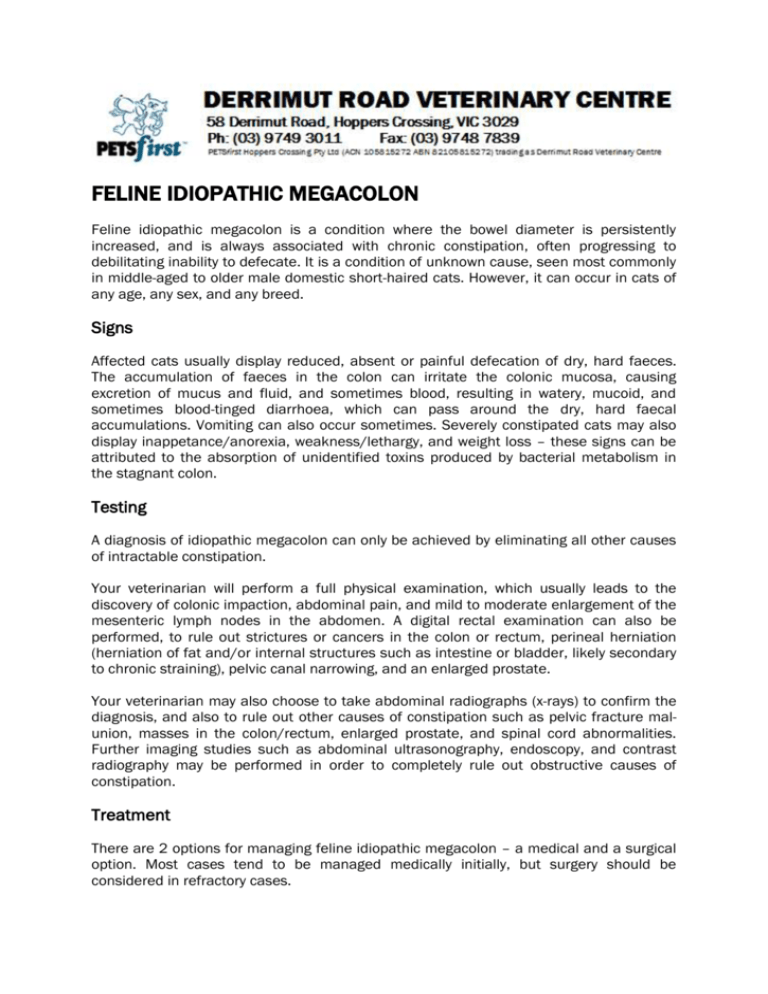
FELINE IDIOPATHIC MEGACOLON Feline idiopathic megacolon is a condition where the bowel diameter is persistently increased, and is always associated with chronic constipation, often progressing to debilitating inability to defecate. It is a condition of unknown cause, seen most commonly in middle-aged to older male domestic short-haired cats. However, it can occur in cats of any age, any sex, and any breed. Signs Affected cats usually display reduced, absent or painful defecation of dry, hard faeces. The accumulation of faeces in the colon can irritate the colonic mucosa, causing excretion of mucus and fluid, and sometimes blood, resulting in watery, mucoid, and sometimes blood-tinged diarrhoea, which can pass around the dry, hard faecal accumulations. Vomiting can also occur sometimes. Severely constipated cats may also display inappetance/anorexia, weakness/lethargy, and weight loss – these signs can be attributed to the absorption of unidentified toxins produced by bacterial metabolism in the stagnant colon. Testing A diagnosis of idiopathic megacolon can only be achieved by eliminating all other causes of intractable constipation. Your veterinarian will perform a full physical examination, which usually leads to the discovery of colonic impaction, abdominal pain, and mild to moderate enlargement of the mesenteric lymph nodes in the abdomen. A digital rectal examination can also be performed, to rule out strictures or cancers in the colon or rectum, perineal herniation (herniation of fat and/or internal structures such as intestine or bladder, likely secondary to chronic straining), pelvic canal narrowing, and an enlarged prostate. Your veterinarian may also choose to take abdominal radiographs (x-rays) to confirm the diagnosis, and also to rule out other causes of constipation such as pelvic fracture malunion, masses in the colon/rectum, enlarged prostate, and spinal cord abnormalities. Further imaging studies such as abdominal ultrasonography, endoscopy, and contrast radiography may be performed in order to completely rule out obstructive causes of constipation. Treatment There are 2 options for managing feline idiopathic megacolon – a medical and a surgical option. Most cases tend to be managed medically initially, but surgery should be considered in refractory cases. Medical Feline idiopathic megacolon can initially be managed by correcting dehydration and acidbase and electrolyte abnormalities, which can occur with prolonged faecal retention. This is followed by stool softeners (laxatives) and enemas. There are several types of laxatives available, and your veterinarian will advise you of the most appropriate one for your cat. The softened faeces are then removed manually under sedation or general anaesthetic. Long-term management involves high-fibre diets (e.g. Hill’s w/d), stool softeners (laxatives), and intermittent enemas as required. Your veterinarian may also prescribe colonic prokinetic agents to enhance to passage of faeces through the digestive tract. In cases where recurrent constipation or debilitation occurs and where the diameter of the colon is too large, surgical treatment should be considered. Surgical The aim of surgical therapy is to remove the enlarged segment of colon, by performing either a “total colectomy” or a “subtotal colectomy”. Follow-Up Following treatment, you will need to monitor your cat for frequency of defecation and consistency of faeces, at least twice weekly initially, then weekly or bi-weekly. It is advised that you keep your cat active, and to feed an appropriate (high-fibre) diet. For surgical candidates, it can be expected that the frequency of defecation will be increased (2-6 times daily), and the faeces produced will be softer than normal faeces. Most cats will start eating 24-48 hours post-surgery. Small-volume watery diarrhoea is usually present for about 5 days post-surgery, but most cats should produce semi-solid non-formed faeces a week post-surgery, and soft formed faeces by 6-12 weeks postsurgery. In some cases, antibiotics may be needed, and your veterinarian will advise you if necessary. Prognosis In cases that are not responding to medical therapy and surgery is performed, prognosis is very good. It has been reported that more than 90% of cats that undergo surgery have an uncomplicated recovery and are able to function “normally” without long-term complications. There is an overall complication rate of 5%, and complications include recurrent constipation, persistent diarrhoea, strictures at the surgical site, death by peritonitis caused by leakage from the surgical site, and death from unknown causes. References Bertoy, R.W. (2002) Megacolon in the cat. The Veterinary Clinics of North America. Small animal practice. 32(4):901-915. Scherk, M.A. (2003) Feline Megacolon. 28th World Congress of the World Small Animal Veterinary Association (Proceedings). Viewed on 20 th September 2007. <http://www.vin.com/proceedings/Proceedings.plx?CID=WSAVA2003&PID=6622&O=Generic> Foster, D. (undated) The management of constipated cats. The Veterinarian. Sydney Magazine Publishers Pty Ltd. Viewed on 20th September 2007. <http://www.theveterinarian.com.au/clinicalreview/article757.asp#> Washabau, R.J. (2001) Feline Constipation, Obstipation, and Megacolon: Prevention, Diagnosis, Treatment. 26 th World Congress of the World Small Animal Veterinary Association (Proceedings). Viewed on 20th September 2007. <http://www.vin.com/VINDBPub/SearchPB/Proceedings/PR05000/PR00118.htm> Moore, L.E. and Burrows, C.F. (2003) Constipation and Obstipation. In: Tilley, L.P. and Smith, F.W.K. Jr. (eds.). The 5-Minute Veterinary Consult. Lippincott Williams & Wilkins, Baltimore. CD-ROM Version 3.0.
